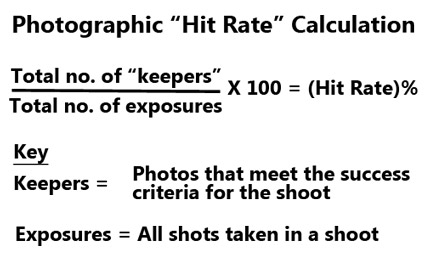![]()
Photographic Hit Rate
The hit rate of an individual photographer can be summed up in simple mathematical terms as follows…
Total no. of ‘keepers’ divided by the total no. of exposures x 100
This calculation yields a percentage hit rate for an individual shoot. A detailed expression for this formula can be seen in the following graphic.

• Hit Rate Calculation •
The hit rate is a plain mathematical calculation. However, the choice of ‘hits’ and the criteria for picking them is relative to the value of the images and the expectations for the shoot.
Examples
The meaning of the terms for “keeper” and “exposure” are best shown by the examples given below.
Example 1. Of 100 exposures made one morning on a fashion shoot, 27 were turned over to the client. The photographer is hard on himself and ruthlessly edits his shots in order to maintain a good reputation.
Thus: 27/100×100 = 27%.
Or in plain English, the photographer had a hit rate of 27% that day (not bad BTW).
Example 2. Fred went to his first air show to photograph aerobatics. He took 320 exposures. Twelve were totally overexposed to white where he caught the sun. 118 photographs were of empty sky – he missed the aircraft as it flew past. One shot was an unidentifiable black spot – a bird? Nineteen photos were underexposed while Fred experimented. Two shots were of grass and one of the wheel of his car. Of the remaining 167 exposures only 34 were any good. He really liked six. He deleted the over and under exposures. He also deleted 34 no-go shots.
What was Freds hit rate for the day?
Simple:
6/320×100= 1.875% (Around 2% is very low – but a difficult subject)
Or, should he have chosen the 34 that were any good? (34/320×100= 10.625%). He makes the choice.
Example 3. After a day at the beach Maggie had taken nine photos. She had used a little point-and-shoot. One of the photos was a bit blurred where her son was chasing into the waves. A couple of the shots were a bit harsh in the sun. But she loved them all. What was Maggies hit rate?
Maggie was pleased with all the shots and she decided to make a little album with all of them. They were not top quality keepers, but she loved her family so much and could not bear to miss out on any of these precious little moments to remind them of a great day. Her hit rate is 100%
Interpretation
As you can see from these examples the rules are simple. The total number of ‘keepers’ is appropriate to the purpose. In other words, the hit rate is relative to the value of the shots and the expectations of the shoot owner.
In the case of the client the no hoper’s; strobe missfires; poor art; bad shots; blinkers, and ugly movements ruled out nearly three quarters of the shots. The photographer gave the client 27 shots which met the brief he was given and demonstrated his status as a professional photographer. The technically poor shots would not impress the client so he edited them out.
In the case of the amateur at the air show he learned a lot, wasted a lot of shots and really only felt satisfied with six. His criteria for success was a shot that approached his personal visualisation of what he wanted from the shoot.
Maggie, the loving mother at the beach was overwhelmed with the emotion of the day. That persuaded her she had a hit rate of 100%. It was her choice and her criteria.
Relativity
Unlike the “hit rate” in other fields (like business sales for example), the successful picks are filtered out based on an arbitrary criteria decided by the ultimate owner of the shots. It’s rarely as high as 100%. Commercial pressure will tend to lower the hit rate. Sentimental shots, in particular, can have a high enough value to turn technically poor shots into keepers. This puts the hit rate up beyond someone else’s “value-based hit rate” for that same group of shots.
Commercial hit rate
Where there is a brief for the shoot, hit rates are less relative. The brief constitutes a statement of expectation by the client. The photographer shoots to meet the brief. However, the photographer is also aware of her reputation. So, she cannot allow the client to see sloppy pictures, poorly conceived images, test shots and other shots of no commercial value,including the inevitable bad shots. Professional photographers are usually pretty ruthless editors of their own work. They will often have a pretty low hit rate as a result. They want to hand over to the client only the best of the best. So, hit rates in a commercial context may be quite low compared to the amateur shooter, snapping and experimenting, with no tight brief and client expectations.
Photographic Glossary – Definitions, articles and resources…
Comments, additions, amendments or ideas on this article? Contact Us



